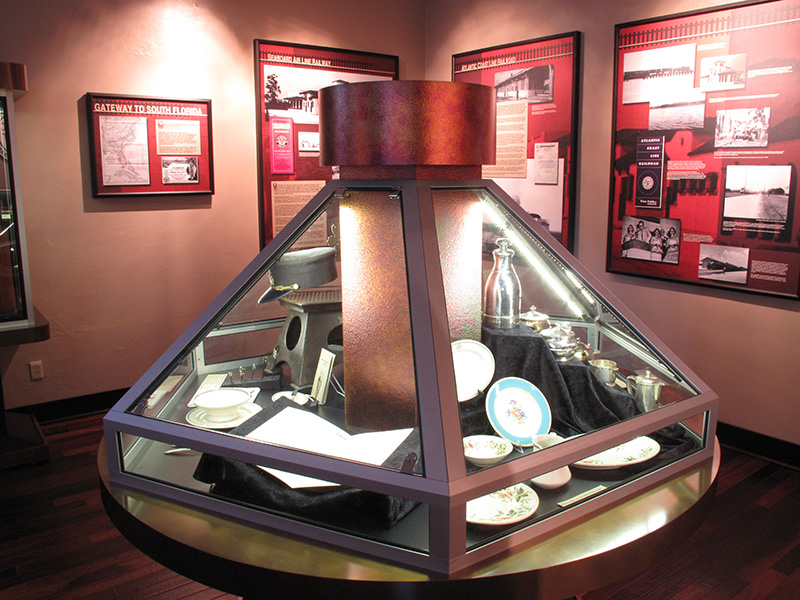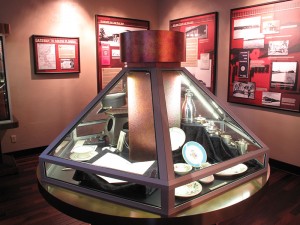 Properly designed and executed exhibit cases will both protect your artifacts and allow your guests to see and appreciate them. They allow the artifact to connect your guests with your story and our shared past.
Properly designed and executed exhibit cases will both protect your artifacts and allow your guests to see and appreciate them. They allow the artifact to connect your guests with your story and our shared past.
While there are many factors that determine how well your cases perform at these tasks, we are going to focus on the glass or vitrines.
You can choose to use either glass or acrylic for your vitrines. If used properly, either one can provide a safe and secure environment for your artifacts. They are, however very different materials and have different relative strengths and weaknesses.
Glass
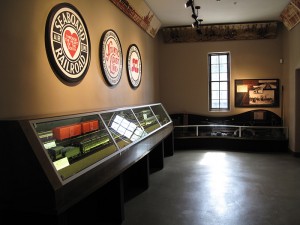 Let’s talk about glass first. Overall it is an excellent choice. You can get it with many different types of U/V protection either in the glass or applied as a coating or film. It is non reactive, holds up well against chemical cleaners, and is scratch resistant.
Let’s talk about glass first. Overall it is an excellent choice. You can get it with many different types of U/V protection either in the glass or applied as a coating or film. It is non reactive, holds up well against chemical cleaners, and is scratch resistant.
One of the tough things about working with glass is that it is difficult to find glass companies that can or are willing to work with precision. Locally, most of the glass companies are used to working to a tolerance of 3/8 of an inch which is way too large for exhibit case work. Luckily we have built relationships with companies who are willing to match our tolerances. Even so, we have to allow for extra time so that we can send pieces back if we need to.
The glass itself can be either tempered glass or safety glass. Choosing the right one depends on the application.
Safety Glass
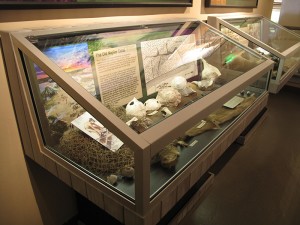 Safety glass is two or more layers of glass laminated together with a film in between them. That film can provide U/V filtering and even tinting if desired. This is the same type of glass as a car windshield. If it breaks, the film will hold the glass together so that most of the glass will not fall into the artifact case. This protects your artifacts. The biggest problem with safety glass is that the layers of glass are thin and brittle. When you try to attach hinges or locks directly to the glass, it easily breaks. To avoid this, you have to use some type of metal extrusion to capture and hold the edges of the glass.
Safety glass is two or more layers of glass laminated together with a film in between them. That film can provide U/V filtering and even tinting if desired. This is the same type of glass as a car windshield. If it breaks, the film will hold the glass together so that most of the glass will not fall into the artifact case. This protects your artifacts. The biggest problem with safety glass is that the layers of glass are thin and brittle. When you try to attach hinges or locks directly to the glass, it easily breaks. To avoid this, you have to use some type of metal extrusion to capture and hold the edges of the glass.
When we work with safety glass, it is always the last thing that we build on the case. Once the case is built and finished, we will build templates for the glass out of mdf plywood. Then we send the templates to the glass company so that they know exactly what to build. If the pieces of glass match the templates, they fit right into the case. If not, we send them back to the glass company until they do.
Tempered Glass
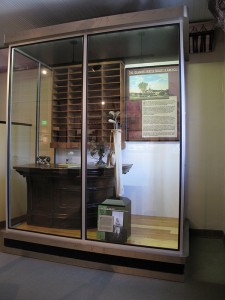 Tempered glass is also a good option. We will use it when the design calls for adding hinges or locks directly to the glass. It is not nearly as brittle as safety glass and usually won’t break when assembling the cases. If it is broken, it will shatter into many small pieces. It will not leave sharp pieces that can cut guests or your staff, but it will leave you with some cleanup inside the case. The weight of the small pieces can also damage especially fragile artifacts.
Tempered glass is also a good option. We will use it when the design calls for adding hinges or locks directly to the glass. It is not nearly as brittle as safety glass and usually won’t break when assembling the cases. If it is broken, it will shatter into many small pieces. It will not leave sharp pieces that can cut guests or your staff, but it will leave you with some cleanup inside the case. The weight of the small pieces can also damage especially fragile artifacts.
The manufacturing process for tempered glass is similar to safety glass, with a few added steps. We will build plywood templates to send to the glass company. They will then cut the glass to the template and drill any holes needed to accommodate hinges or locks. They sand the edges to get rid of any imperfections and make it safe. Then they send the glass out to be tempered. Once the glass is tempered, you can no longer cut, sand, or drill it. We get the glass back and mount it to the cases. If it fits, all is well. If not, then we send it back with the template to be cut, drilled, sanded, and tempered again until it does fit.
Acrylic
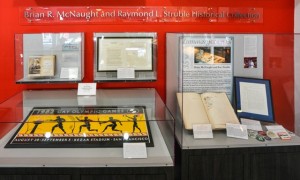 Acrylic is a versatile material that offers a lot of advantages over glass. You can weld pieces together to form vitrines that do not need metal extrusions to hold them together. This makes a clean look that is much lighter than glass. Being lighter means it is easier for staff to manage and it is much less likely to be damaged during handling. It is easy to cut with precision so intricate and complex pieces are possible. It can even be bent or molded to achieve shapes that would be very difficult with glass.
Acrylic is a versatile material that offers a lot of advantages over glass. You can weld pieces together to form vitrines that do not need metal extrusions to hold them together. This makes a clean look that is much lighter than glass. Being lighter means it is easier for staff to manage and it is much less likely to be damaged during handling. It is easy to cut with precision so intricate and complex pieces are possible. It can even be bent or molded to achieve shapes that would be very difficult with glass.
Ultra Violet Filtering
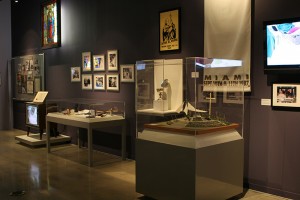 Almost all acrylic products that you can buy these days incorporate some type of UV filtering. That filtering is included mostly to protect the acrylic itself and only filters part of the UV spectrum. In order to get full spectrum UV protection for your artifacts, you need to use a special kind of acrylic.
Almost all acrylic products that you can buy these days incorporate some type of UV filtering. That filtering is included mostly to protect the acrylic itself and only filters part of the UV spectrum. In order to get full spectrum UV protection for your artifacts, you need to use a special kind of acrylic.
Here is where it gets a little tricky. Acrylic can be manufactured by either an extrusion or a casting process. Most acrylic is extruded. This gives you a product that is uniform in thickness, and easy to work with. Acrylics that offer full spectrum protection are produced by a casting process. That means that there are very small variations in the thickness of the finished sheet. It takes more time, care, and precision to get clean welded seams, but you are offering the best possible protection for your artifacts.
What is the Best Solution for Your Artifact Cases?
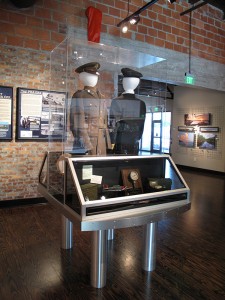 The answer to that depends a lot on aesthetics. There is a certain sparkle that you get when using glass and it has a substantial and timeless quality. Acrylics allow you to achieve a more modern, clean, and open look. So, let your design goals drive your material choice. Either way, you can achieve excellent protection for your artifacts.
The answer to that depends a lot on aesthetics. There is a certain sparkle that you get when using glass and it has a substantial and timeless quality. Acrylics allow you to achieve a more modern, clean, and open look. So, let your design goals drive your material choice. Either way, you can achieve excellent protection for your artifacts.
We would love to talk to you about the best way to achieve your design goals.

